Trinidad Travel Guide
One of the most visited towns in Cuba, Trinidad maintains a charming colonial atmosphere with its uneven cobbled streets, quiet plazas and old Spanish missionary churches. Bicycles and horse-drawn carts bump along streets lined with somewhat pastel-coloured houses worn with age, while the strains of salsa music drift out from cool courtyards where the intricate steps of the dance are practised.
Designated a UNESCO World Heritage Site in 1988, Trinidad has largely escaped the modern tourist infrastructure and doesn't have the large hotels usually accorded to a popular destination, allowing it to retain its welcoming and tranquil atmosphere.
Surrounded by sugarcane plantations and situated between the Topes de Collantes Mountains and the Caribbean Sea, Trinidad's location also provides easy access to the beach, the mountains and the beautiful surrounding countryside.
Vestiges from the 18th and 19th centuries in the Valle de los Ingenios (Valley of the Sugar Mills) testify to a time of immense prosperity for landed Cubans, who gathered immense wealth during the sugarcane boom under slavery and colonial rule. It was after the abolishment of slavery that the boom ended and the area drifted into picturesque tranquillity.
Things to do in Trinidad
A holiday in Trinidad provides an enchanting taste of traditional Cuba. The centre of Trinidad is a living colonial museum where visitors can enjoy evenings of salsa performances in the central square, and where bars serve up delicious mojitos. Attractions include the largest church in Cuba, Iglesia Parroquial de la Santisima. An extraordinary white interior makes the church feel light, cool and vast. So much of Trinidad's charm is owed to its well-preserved colonial architecture. The Museo Historico Municipal, Trinidad Architecture Museum and the Museo Romantico are all stunning examples of mansions that have been turned into museums. They house collections composed largely of the private belongings and art of the wealthy and influential families that once lived in them. Both are on the Plaza Mayor, the old town square.
Trinidad is also remarkably well situated for excursions out into the countryside. It is just a few minutes' drive from one of Cuba's loveliest beaches, Ancon, and the Embalse Hanabanilla lake and waterfalls, which are immensely popular with hikers and cyclists. Also nearby is the beautiful and historically absorbing Valle de los Ingenios, while it hardly takes any time to reach the nearby city of Sancti Spiritus, a continuation of the rustic colonial glory of Trinidad.
The best time to travel to Trinidad is during the cool, dry months between December and April, which is high season for tourism in Cuba. The weather is sweltering, humid and wet for the rest of the year.
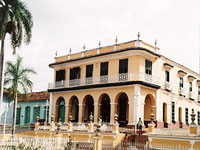
Museo Romántico
Museo Romántico overlooks Plaza Mayor, the historic centre of Trinidad and a UNESCO World Heritage Site. The mansions and palaces surrounding the square date back to the 18th and 19th centuries, when trade in sugar and slaves brought huge wealth to the area. Also called Brunet Palace, the Museo Romántico mostly displays the personal collections of paintings, furniture and porcelain belonging to its previous owners. While the plaza and nearby houses are all unmissable attractions in Trinidad, the neoclassical Museo Románticoi is itself magnificent, with original marble floors and splendid frescoes.
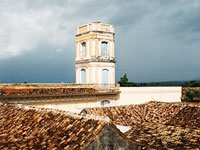
Museo Histórico Municipal
The grandiose Museo Histórico Municipal is a beautiful site. Previously owned by one of the richest families in Cuba, there are murals depicting well-known classical scenes and its rooms are outfitted in decorative splendour. Exhibits hark back to its original past, covering the sugar industry and history of Trinidad, including collections of weaponry, furniture and art. One of the most popular attractions of this neoclassical mansion is the captivating view from its tower, capturing wonderful vistas of Trinidad and the Escambray Mountains.
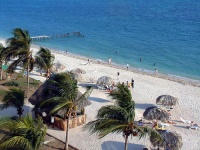
Ancón Beach
Situated seven miles (12km) south of Trinidad at the end of the peninsula, Playa Ancón boasts soft sand, warm waters and a fitting backdrop of palm trees. There are many watersports at Playa Ancón, as well as good offshore snorkelling and dive sites. Scuba enthusiasts will revel in this underwater playground of rock tunnels and colourful coral. Visitors can guide yachts through the beach's surrounding waters to find that perfect swimming spot or even hire boats to go fishing or exploring along the coast. Travellers also enjoy the countryside while taking a leisurely bicycle ride to Playa Ancón from Trinidad, passing through a picturesque old village on the way.
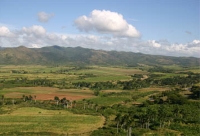
Valle de los Ingenios (Valley of the Sugar Mills)
This emerald valley was once the centre of the sugar industry in Cuba in the 18th and 19th centuries. At its peak, there were over 70 sugarcane mills and about 30,000 slaves working on the plantations. Today, the ruins of estates and mills are visited by tourists attracted by the region's beauty and its historical significance in the slave trade during the valley's boom years. The main site is the Manaca Iznaga, a striking 144ft (44m) high tower which was used by plantation owners to keep watch over slaves. Along with Trinidad, the Valle de los Ingenios has been declared a UNESCO World Heritage Site, and riding tours are a popular way to take in the area's lovely views.
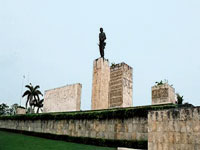
Santa Clara
The city of Santa Clara is best known for the Che Guevara Mausoleum and other monuments relating to the Cuban Revolution. The Tren Blindado marks the spot where Guevara attacked the train carrying Batista's troops and derailed the tracks with a bulldozer. The Mausoleum was built to pay homage to the memory of Guevara and his comrades who fought with him in Bolivia, and the enormous monument incorporates a huge statue of his likeness, as well as representations of many aspects of his revolutionary life. To one side of the statue, a huge stone block has been inscribed in full with his farewell letter to Fidel Castro.
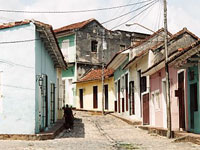
Sancti Spiritus
Sancti Spiritus lies on the banks of the Yayabo River, its delightful architecture and winding cobblestone streets exuding charm, authenticity and friendliness. Pedestrians enjoy ice-creams flavoured with fruit, while dodging jams of horse-drawn carriages, bicycles and scooters. The old town is a National Monument dating back to 1514, filled with stately colonial homes and colourful houses beneath red tile roofs. It also boasts the Parroquial Mayor, Cuba's oldest church, and the Puente Yayabo, a bridge over the river that is the city's most famous sight. The city is the birthplace of many famous Cuban musicians, so it's worth checking out the local music scene.
Getting Around
Trinidad is relatively easy to negotiate on foot as most attractions are in the historic hub, centred around the Plaza Mayor. It is a charming and generally safe town for pedestrians and getting around on foot somehow suits the ponderous pace of life in Trinidad.
Playa Ancon's beaches are serviced by minibuses, usually from about 8am until dusk, running along Maceo. Taxis are available, as are car rental agencies, though streets can be somewhat labyrinthine and are known by different names, which can make driving confusing. Travellers won't struggle to hire a horse-drawn wagon either, should the urge strike them.
A novel way to explore is on the vintage steam train, whiich dates back to 1907 and travels to Valle de los Ingenios. It generally leaves Trinidad at about 9.30am and returns at 2pm. There are also popular horseback tours of the valley, and many people get around the area on bicycles. Ultimately, it's a small and friendly place and exceedingly easy to get around.
Trinidad Climate and Weather
Trinidad has a moderate subtropical climate with two seasons. The dry season runs from November to April, and the humid season lasts from May to October. The best time to visit is during the tourism high season, which takes place in the dry months between December and April, when the average high is 84F (29C). Peak hurricane season runs from May to October.
Cuba travel info
Electricity
Most older hotels use 110 volt power, 60Hz, while newer hotels use 220 volts, 60Hz. A variety of outlets are in use, but the flat and round two-pin plugs are most common.
Language
The official language is Spanish, but English is spoken in the main tourist spots.
Money
The official currency is the Cuban Peso (CUP), which divided into 100 centavos. The Peso Convertible (CUC) functioned as a 'tourist' currency but was removed from circulation in January 2021 as part of the Cuban government's currency reform. The Cuban National Peso is the only legal cash currency in Cuba, though private hotels, bars and restaurants usually accept cash payments in dollars or euros. Sterling is not widely accepted.
Visa and MasterCard are generally accepted only in major cities and hotels as long as they haven't been issued by a US bank; Diners Club has limited acceptance, and American Express is not accepted anywhere on the island. No US-issued credit or debit cards will work in ATMs, but those holding cards issued in other countries should be able to get pesos at most major tourist destinations.
Tipping
A 10 percent tip is appreciated in restaurants and by taxi drivers.
Health
Mosquito repellant is useful as chikungunya and dengue fever do occasionally break out, even in urban areas such as Havana, and visitors are advised to take precautions against typhoid, particularly if travelling to rural areas. Medical facilities in Havana are better than elsewhere in Cuba, but visitors may need to be medically evacuated if they need specialist care. Those requiring regular prescription drugs should bring them, along with a copy of the prescription and a doctor's letter to facilitate entry through customs. Travel insurance with provision for emergency repatriation is compulsory for visitors to Cuba.
Safety
Cuba is considered comparatively free from the threat of global terrorism, but visitors are advised to be vigilant regarding crime. Theft from baggage in airports is common, and valuables should not be packed in suitcases; travellers should be wary of pickpockets and bag snatchers in Old Havana, at major tourist sites and on buses and trains. Visitors are advised to take taxis after dark rather than walk but should always make sure taxis are registered.
If there are political demonstrations of any kind, travellers should avoid them, as Cuban authorities are known to clamp down on street protests quickly and sometimes violently. Tropical storms and hurricanes usually occur between June and November. Although good warning is usually given, electricity, water and communications can be disrupted for weeks.
Local customs
Visitors should address Cuban men as 'senor' and women as 'senora'. While many Cubans will engage in political discussion and debate, it is not advisable to criticise the government too vocally and it's best to be respectful of revolutionary figures such as Fidel Castro and Che Guevara.
Homosexuality is legal in Cuba but public displays of affection between same-sex couples are not always well received by locals. The penalties for possession of illegal drugs are very strict, as are the penalties for any breach of Cuban immigration rules.
Doing business
Cubans tend to be warm and hospitable, and business is conducted more informally than in many other countries. Establishing a good relationship is vital to successful business and some time may be given over to small talk. Owing to relative isolation from the global economy, business in Cuba tends to take some time and effort, and one is often hemmed in by the country's communist practices.
Punctuality is always important, but foreigners shouldn't expect meetings to begin on time or deals to be struck quickly. The dress code tends to be more casual than elsewhere, but businesspeople still usually wear collared shirts and the dress code for women is sophisticated. Business hours are usually about 8.30am to 12.30pm and 1.30pm to 4.30pm, Monday to Friday. Some businesses are open every second Saturday.
Duty free
Travellers to Cuba who are over 18 years do not need to pay customs duty on 400 cigarettes or 50 cigars or 500g of tobacco; 3 bottles of alcoholic beverages; medicines and perfume for personal use; and gifts to the value of CUP 1,000.
Communications
The international code for Cuba is +53. WiFi availability in Cuba is expanding rapidly and hotels will often provide access, but there is still limited connectivity. A prepaid NAUTA internet card is needed and is purchasable from a ETECSA station located throughout major cities or at upscale hotels. Once visitors have a NAUTA card they'll need to find a WiFi hotspot in a modern hotel or WiFi park.
Passport & Visa
In lieu of a visa, a Tourist Card ("Tarjeta del Turista") may be issued by tour operators, travel agents, or airlines for a single-entry holiday trip of up to 30 days, provided accommodation has been pre-booked and paid. A return ticket or proof of onward travel is required, as well as sufficient funds to cover the period of intended stay in Cuba (US$50 or equivalent per person, per day). All those entering Cuba must hold travel insurance, with coverage in Cuba, to ensure cover of medical expenses for the period of stay. It is highly recommended that travellers' passports have at least six months' validity remaining after the intended date of departure from their travel destination. Immigration officials often apply different rules to those stated by travel agents and official sources.
Entry requirements
US nationals must have a passport valid on arrival. A visa is also required.
British nationals must have a passport valid on arrival. A visa is also required if the visitor does not have a Tourist Card.
Canadian citizens must have a passport valid on arrival. A visa is also required if the visitor does not have a Tourist Card.
Australian citizens must have a passport valid for a minimum of two months from the arrival date. A visa is also required if the visitor does not have a Tourist Card.
South African citizens must have a passport valid on arrival. A visa is also required if the visitor does not have a Tourist Card.
Irish nationals must have a passport valid for two months beyond the date of arrival. A visa is required if the visitor does not have a Tourist Card.
New Zealand citizens must have a passport valid for two months beyond the date of arrival. A visa is required if the visitor does not have a Tourist Card.
Useful contacts
Official Tourism Portal, Cuba: www.cubatravel.cu
106 (police), 104 (ambulance), 105 (fire department)Embassies / consulates in other countries
Cuban Embassy, Washington DC, United States: +1 202 797 8518.
Cuban Embassy, London, United Kingdom: +44 (0)20 7240 2488.
Cuban Embassy, Ottawa, Canada: +1 613 563 0141.
Cuban Embassy, Canberra, Australia: +61 2 6286 8770
Cuban Embassy, Pretoria, South Africa: +27 (0)12 346 2215.
Cuban Embassy, Dublin, Ireland: +353 (0)1 671 8300.
Cuban Embassy, Wellington, New Zealand: +64 (0)4 464 2210.
Embassies / consulates in Cuba
US Embassy, Havana: +53 (0)7 839 4100.
British Embassy, Havana: +53 (0)7 214 2200.
Canadian Embassy, Havana (also responsible for Australia): +53 (0)7 204 2516.
South African Embassy, Havana: +53 (0)7 204 9671.
Irish Embassy, Mexico City, Mexico (also responsible for Cuba): +52 55 5520 5803.
New Zealand Embassy, Mexico City, Mexico (also responsible for Cuba): +52 55 5283 9460.



